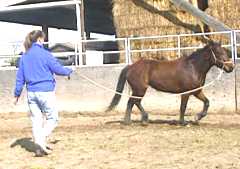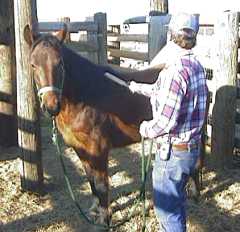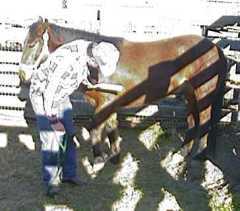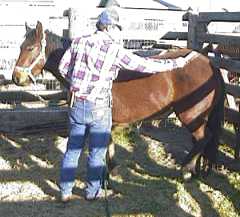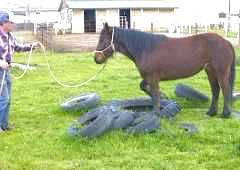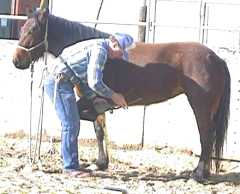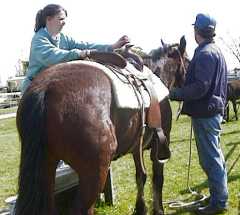Why Grooming is Important
|
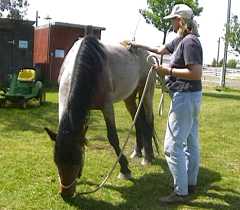
|
|
Much has been written and taught about round penning, working with a pole,
working on lines and other methods to train wild or unsocialized horses.
These are important skills, however they represent only part of the process
of truly gentling a wild horse. Particularly with horses of a stand-offish
nature, limiting your work to only these methods will often come up short
of the results that you need.
The Typical Scenario: "Help! My horse moves nicely on the line and leads for me, but she knocks the farrier down when he tries to trim her and my vet won't touch her!" Many wild horses figure out pretty quickly how to deal with humans in the round pen or on the line. Their nature is to move forward and the handler exploits that nature to get the horse to walk, trot, yield and back up. It all looks very impressive, but what's often missing is the ability for that forward moving horse to stand quietly while someone is up close and personal. Even more critical is for the horse to be able to relax while someone is picking up and working on his foot. Yet constantly vets, farriers and others are asked to work on tense, reactive horses that may not be able to maintain their balance or may react violently when they reach their stress limits in a confined situation. |
Round penning looks great...then worked on motion skills 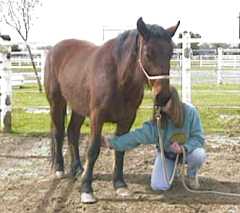
|
| GROOMING OBJECTIVES |
| Aside from the obvious element of being able to clean your horse, grooming has specific training advantages. If you groom properly and are sensitive to the horse, the process of being groomed should provide physical and social comfort to the horse and the training objectives are beneficial byproducts. Grooming should be an important element of the bonding process between horse and handler. |
|
Getting into the horse's space:
Horses naturally don't like predators in their personal space. Additionally, a horse's space is generally off-limits to a lesser ranked horse unless an invitation is offered, usually in the form of the more dominant horse offering some reciprocal grooming. While to a wild horse, having a human rub a brush over a him is a foreign concept, most horses figure out pretty quickly that this is how those strange two legged creatures do their grooming and accept the process as not only something to tolerate, but something to appreciate. Once that connection is made, the handler is coming from the more dominant space of initiating grooming which reinforces the much needed hierarchical relationship between handler and horse. |
Body language tells a lot.
|
|
Making Contact with the Horse:
In the early going, making contact with a wild or unsocialized horse is a tenuous process at best. The horse, who doesn't have good depth perception, is programmed to avoid any movement which is threatening or unfamiliar. A tiny mistake on the handler's part and the horse is likely to react in flight. However for both practical and safety reasons we want the horse to be comfortable with our making contact anywhere without reacting by leaving, kicking, pawing or biting. Once the horse accepts being groomed, the handler can retract the brush and make repeated contacts. When done correctly the horse should consider, rather than react to the contact and be conditioned to the concept that being touched by humans is not fundamentally a bad thing. |
Making contact: Her ears are
|
|
Expanding the Safe Zone:
Most horses have safe zones and forbidden zones. Safe zones may include the horse's face or shoulder. Forbidden zones may include flanks, belly, legs, ears, etc. These areas differ from horse to horse due to their horsonalities as well as their previous experiences. Grooming provides a relatively low intensity way to expand into areas that are unsettling to the horse. The grooming process itself is relaxing and positive so it is mainly a matter of engaging in sensible "advance and retreat" into these areas until the horse is desensitized. |
As the "safe zone" expands,
|
|
Learning About the Horse:
A horse is an emotion in physical form. He is what he feels. Therefore he also is what he fears. It's important that the handler safely discover all the scary physical elements of the horse. Also for the horse to lower his guard and be more tractable during training, he has to release all those scary areas to the handler. This requires the trainer to desensitize the horse so that he is confident, not only when being touched by the handler, but also when encountering other situations which could impact his emotional well being and self confidence. |
The horse is confident enough to
|
| THE END PRODUCT |
|
Before I get under a horse to trim, he has to be able to tolerate my
touching him all over, not only along the legs but in the thigh and belly
areas. It is possible to trim the horse while he is barely tolerant of having his legs
handled, but accidentally poke him in the belly with an elbow or a nipper
handle and he's likely to explode over the top of me. The horse must be
be desensitized to human touch.
Similarly if the horse needs a vaccination, worming or an injury treated, he needs to be calm about being touched and handled in order to effectively deal with whatever it is that we have to do to him. Good grooming techniques sets up success for saddling and bridling. The horse is no longer guarding areas on his body so he can cope with strange objects touching him. A relaxed saddling leads to calmer packing of the saddle and a quieter response when the handler finally mounts up. This is, of course, the culmination of a step-by-step process which involves a number of activities. But the foundation was laid when the horse was first being handled through good grooming techniques.
|
Body language tells a lot.
|
|
Important Note: If you take on the project of developing an untrained horse, everybody will want to give you advice. Don't act on any advice, including the ideas offered in this site, unless it makes sense to you and fits your individual situation. Your abilities and the sensitivities of your horse(s) may differ from the examples given. Be alert and rational with your actions so neither you nor your horse will get hurt. This information is offered as illustrations of what we do and the reader must apply common sense since he or she is solely responsible for his or her actions. Happy trails!Press "Back" to return to the page that brought you hereGo to Case Study SectionReturn to Training SectionReturn to Wild Horse MentorsReturn to KBR World of Wild Horses and BurrosGo To
| |

